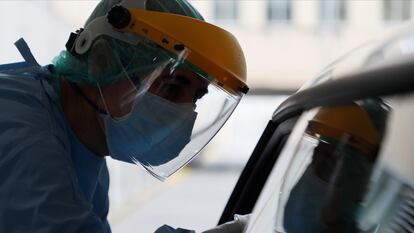A snapshot of new coronavirus outbreaks in Spain: Two ‘comarcas’ confined and two buildings in quarantine
Since the end of the state of alarm, spikes in cases have been detected in nearly all of the country’s 17 regions

Several areas in Spain have been forced to reintroduce lockdown measures due to new coronavirus outbreaks. In the two weeks since the state of alarm came to an end, nearly 300,000 residents in Lleida province in Catalonia and Lugo province in Galicia have been confined to their comarcas following a spike in infections; another 80,000 people in the northwestern region of Aragón have been moved back to Phase 2 of the government’s coronavirus deescalation plan; two buildings – one in Santander and another in Albacete – have been placed under quarantine; and around 50 coronavirus outbreaks are being monitored across the country. Of Spain’s 17 regions, only Asturias and La Rioja have not reported a coronavirus outbreak.
Now that Spain has entered what has been dubbed the “new normality” following a prolonged lockdown and deescalation process, it is up to regional authorities – not the central government – to manage and control Covid-19 outbreaks. Regional governments must decide what measures to take, when to take them and where, working with guidance from the Health Ministry, which it must also inform. The solutions, as evidenced by the measures taken so far, are varied. An area does not need to record a minimum number of coronavirus cases for it to be placed under confinement. Decisions, instead, are based on what public-health experts believe is needed to contain the virus.
Detecting these outbreaks shows that the strategic capacity of our healthcare system and the regions for early detection is much better equipped todaySpanish PM Pedro Sánchez
In the province of Huesca in Aragón, four comarcas – a traditional administrative area in parts of Spain – were moved back to Phase 2 of the deescalation plan, but no restriction was placed on movement. In A Mariña in Lugo and Segrià in Lleida, meanwhile, the respective regional authorities chose to confine residents to each comarca, with no one allowed to enter or leave with the exception of those who need to for work.
Regional authorities are also responsible for reporting any coronavirus outbreak to the central Health Ministry. An outbreak is defined by the ministry as a group of three or more infections with an epidemiological link, and it is considered active if there has been transmission within the last 14 days. In the case of infections detected in senior centers, one positive case is considered an outbreak, even if the patient is asymptomatic, due to the high level of risk.
But while regional governments must report an outbreak, the Health Ministry is not publishing this information. The number of outbreaks in Spain is based on information provided by regional authorities that is published by local media, and the responses of Fernando Simón, the director of the Health Ministry’s Coordination Center for Health Alerts (CCAES) at the government’s bi-weekly press conferences. There is no official press release to announce that one has come to an end, which in epidemiological terms occurs when no new cases have been detected after two incubation periods – in other words 28 days. This means it is almost impossible to get a clear picture of the coronavirus outbreaks in Spain.
Some regional authorities provide comprehensive information about spikes in cases, while others share very little detail. The Madrid regional government, for example, reported on Friday that an outbreak had been detected in a company, but provided no further information about the business or where it was located. In contrast, the regional government of Castilla-La Mancha shared the street address of the building in Albacete that is under quarantine after eight people from two families tested positive for Covid-19.
Catalan authorities have provided few details about the outbreak detected in the Segrià comarca. The Catalan health chief, Alba Vergés, justified the decision to confine the area due to the rising number of cases, but at no point specified how many infections had been detected. “The epidemiological figures have led us to believe that the incidence in Segrià is much higher than the Catalan average. We have been alert for weeks and we have been following the evolution day by day,” said Vergés. “This makes us think that there is an upward trend and that we have to take measures,” she added.
Some regional authorities provide comprehensive information about spikes in cases, while others share very little detail
It is also unclear whether the outbreak in Segrià is linked to the cases detected in the comarcas of Aragón, which were moved back to Phase 2. Given the proximity of the two areas and the fact that the outbreak has affected fruit pickers in both instances, a connection seems likely but has not been confirmed. The Catalan health department also did not respond to questions about why the regional government decided to confine Segrià just 24 hours after saying that such a measure was not a possibility. The department tried to avoid the issue, saying that it had been in Lleida until “very late at night” and had met with several institutions.
The central Health Ministry warned that outbreaks would be likely once Spain entered the “new normality” and that selective quarantines – like the ones in the comarcas in Lleida and Lugo – would be needed to control them. Health Minister Salvador Illa made this point on more than one occasion: “If more robust actions have to be taken, in the sense of more surgical confinements, it will have to be done.”
Spanish Prime Minister Pedro Sánchez said the detection of outbreaks showed that the healthcare system was better prepared – a point that has also been repeated by health experts. “Now that we are seeing outbreaks, I want to communicate a message of security and calm. Detecting these outbreaks shows that the strategic capacity of our healthcare system and the regions for early detection is much better equipped today than it was in March, when we did not not know how to act and stop the pandemic,” he said on Sunday.
What health experts do not expect, although it hasn’t been ruled out completely, is a return to the nationwide confinement measures that were introduced under the state of alarm.
English version by Melissa Kitson.
Tu suscripción se está usando en otro dispositivo
¿Quieres añadir otro usuario a tu suscripción?
Si continúas leyendo en este dispositivo, no se podrá leer en el otro.
FlechaTu suscripción se está usando en otro dispositivo y solo puedes acceder a EL PAÍS desde un dispositivo a la vez.
Si quieres compartir tu cuenta, cambia tu suscripción a la modalidad Premium, así podrás añadir otro usuario. Cada uno accederá con su propia cuenta de email, lo que os permitirá personalizar vuestra experiencia en EL PAÍS.
¿Tienes una suscripción de empresa? Accede aquí para contratar más cuentas.
En el caso de no saber quién está usando tu cuenta, te recomendamos cambiar tu contraseña aquí.
Si decides continuar compartiendo tu cuenta, este mensaje se mostrará en tu dispositivo y en el de la otra persona que está usando tu cuenta de forma indefinida, afectando a tu experiencia de lectura. Puedes consultar aquí los términos y condiciones de la suscripción digital.









































